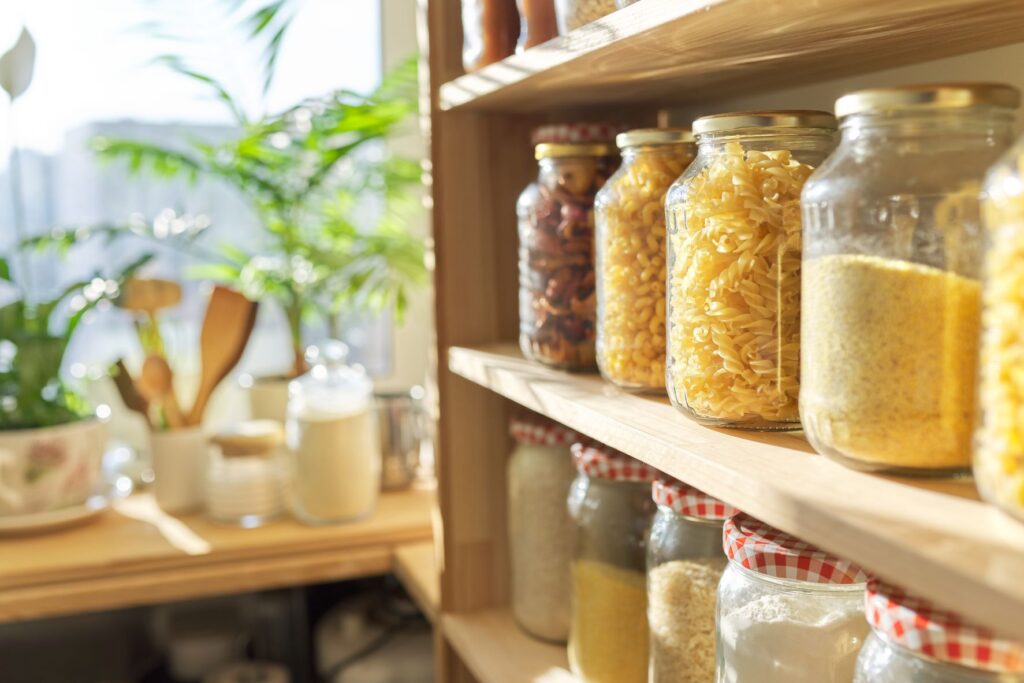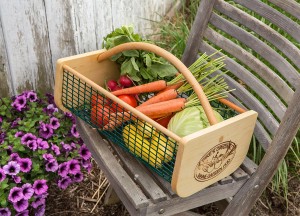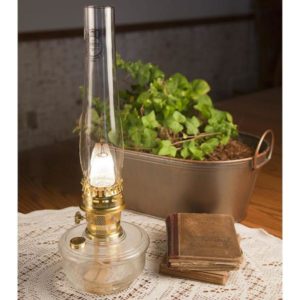With all the uncertainty in the world, having extra food on hand is a wise idea. Rather than depending on frozen foods (which are vulnerable to power outages), consider building a supply of shelf-stable foods which aren’t affected by a loss of electricity. But how do you go about building up such a supply? Here are some suggestions.
- Your shelf-stable food supply should be a mixture of quick meals (such as canned soups, stews, tuna, etc.) and a wide variety of components from which scratch meals can be created..
- Eat what you store and store what you eat. It does no good to store, say, garbanzo beans if you loathe garbanzo beans. Inventory your family’s tastes, and plan your pantry accordingly.
- Learn to cook from scratch rather than buying pre-packaged foods. Aside from a few convenience foods (canned soups or stews, boxed meals, etc.), the majority of your pantry should consist of staples, which are the building blocks for endless meals. Some of the best recipe books for cooking with shelf-stable ingredients are written by Plain women (Amish and Mennonite cookbooks). Two of my favorites are “The Mennonite Community Cookbook” and “Cooking with Dried Beans.”
- Learn a food-preservation skill (such as dehydrating, canning, fermenting, root cellaring, freeze drying, etc.). Learning to preserve food will allow you to save your garden harvest each year, and/or take advantage of farmer’s markets and in-season produce.
- For popular ingredients such as rice or flour, buy in bulk. For storing bulk dry foods, I’m fond of food-grade buckets, which can hold anywhere from 25 to 40 lbs. of food. These buckets are food-safe, stackable, and protect the contents from pests and moisture. (Hint: a bucket opener is a huge help.)
- Date your inventory. This makes it far easier to use the oldest item first and keep your stock rotated.
If building a shelf-stable food supply seems overwhelming, just remember how to eat an elephant: One bite at a time.
Start a log of everything you use while preparing meals over the period of, say, a month. This will give insight as to whether you depend too much on pre-packaged convenience foods, as well as an idea of how many staples (flour, oatmeal, sugar, etc.) you go through.
Next, assemble two weeks’ worth of recipes your family enjoys which use shelf-stable ingredients. It might take some time to find these recipes, but once you have them in a notebook, you can start stockpiling the necessary elements. Rice, dry beans (including lentils), and pasta are some of the most popular beginning storage items, and are very inexpensive (don’t forget spices to jazz them up).
Categories for your shelf-stable foods should include fruits and vegetables (canned, dehydrated, or freeze-dried), meats, dry staples (whole grains, cornmeal, pasta, rice, etc.), sauces (soy sauce, barbeque sauce, etc.), cooking aids (baking powder, baking soda, vinegar, cocoa powder, cream of tartar, cornstarch, vanilla, powdered milk, powdered eggs, etc.), fats (olive oil, vegetable shortening, etc.), sweeteners (sugar, honey, stevia, etc.), spices, and even comfort foods.
Shelf-stable foods store best in cool, dry, dark areas. Hot garages or attics aren’t the best location. If you don’t have a dedicated pantry, consider unorthodox locations such as a closet, under beds, or skirted coffee/end tables.
It takes time to build a shelf-stable food supply, but the peace of mind is well worth it.
Note: First posted in September 2022.


































Food grade buckets sound good, but rodents can chew through plastic. I have a cat, who is a good hunter, but are there any tips for keeping rodents out of your buckets? We’ve a lot of trouble with squirrels chewing up plastic engine parts of our cars.
One could use metal garbage cans to store dry goods. They come in several sizes. Would also like a recommendation for a food sealer to lock out air for freezer or dry goods.
Stored food should be stored above floor level at least 4 inches. In most areas it is required for restaurants and even food pantries. This helps against vermin.
I bought 34 gallon Behrens(made in USA) metal garbarge cans for my basement storage
I am buying a food sealer and the buckets to double protect the food. I have no rats or mice so I think I’ll be fine. We have an old house with a nice size root celler shelved and cool and rows of shelving in the basement. I have been stashing for a few years now not even close to where I need to be but trying. Money is tight so buying that expensive survival food is hard. one #10 can at a time is all I can do.I do have a good amount of Tuna,Salmon, Herrings and canned chicken and beef. Cases of pet food is always a problem getting but I at least have a few months ahead.medications,paper good I have about 6 months, water I really need to up my game on that.,powdered drink mixes,coffee tea and cream all pretty good not optimal yet. That being said ya gotta start somewhere…………….
I can everything. I have found that canned meat is simple, tasty and very tender. You can season it or not, depending. Mostly I can the leftovers from roasts or ox tails or turkey/chicken dinners.so seasoning is already done. Of course, veggies and fruit are a must. I even can water when, at the end of my run, I have a jar or two empty space in my canner. Those jars of water have come in very handy when power is out and the well pump is not working.
I use aluminum trash cans. Place my inventory in separate bags and put 30-50 gallons of food in a can. Got my first can for Christmas 2 years ago. My wife thought I was crazy to ask for a trash can for Christmas. Expensed out over the years, it is cheaper than losing food to rodents.
Good Post. I feel that it is important to diversify the ways of preservation: canning, freezing, dehydrating, freeze dried,etc. That way, if you loose some to ..whatever, you will still have some other style.
Unfortunately, the Amish are not good about using organic, non GMO ingredients, and use a lot of commercially prepared foods. For those of us who DO prefer organic over non organic, they aren’t a good source for cook books (I bought one several years ago only to find out they used mostly commercial, conventional, prepared foods). Better to find the type of cooking/ingredients you like, THEN find the cookbook that offers that type of cooking.
Buckets are great and bulk food buying is important! I use bamboo pillowcases inside them to keep the food from touching the plastic, as it WILL leach into the food. And YES, the bucket opener is so important! (unless you get those Gamma seals, which take a bit of labor to use: you have to hammer the collar in place but after that they are well worth it!..but I still have 4 bucket openers)
Bay leaf works great for keeping mice out
Patrice,
I worry about chemicals in the plastic buckets leaching into my food, even though the buckets are BPA-Free. Aren’t there other chemicals in the plastic that are harmful and leach? What about the chemicals that replaced the BPA chemicals; have the long-term effects of those chemicals been tested yet?
I can and vacuum seal everything. Using Half gallon glass jars (outside the earthquake zones) lets me store dry goods in usable quantities, more practical for a family of 2, than plastic buckets. And for those of you who think you don’t have those rodents that can/do chew their way into a plastic bucket, in a crisis, they will come from “nowhere.”
Hi. Does anyone have any great and inexpensive ways to keep moisture out of home, so that prepped food stays dry? I don’t have enough room for all jar containers. I use food grade buckets, #10 cans, glass, and mylar in buckets. But here in the South there is so much humidity! Sure, I use a dehumidifier, but can’t run non stop. For now, I just knock 10 years off the shelf life for freeze dried foods, and keep rotating other food.
Great Article, Thk You! Grma Bita
:-)
I get the #10 cans of vegetables and dehydrate the contents and vacuum pack it. takes less storage space and cooks up faster
I have been getting dehydrated meals packed in mylar bags from 4Patriots. Most of their foods come from the depot in Idaho. the meals are tasty and feed a family of 6 with each packets.
I have those gamma seals on 5 gallon buckets which I put special mylar type silver bags with oxygen removing sachets and mixed a little food grade diatomaceous earth into rice, beans and wheat inside the buckets.
Great article. I like the idea of the aluminum trash cans instead of plastic. But watch your cans. If you are setting them on concrete, the metal can deteriorate pretty quick. The same for dirt floors that can be damp.